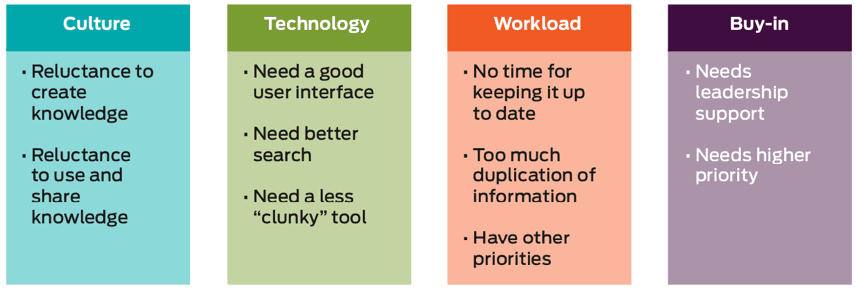Over and over again, we hear the same question: “How can we get users to go to our self-help portal?” Maybe, as is often the case, the answer is contained in the question – and we’ll come back to that later.
In order to find out more about the current state of self-help and knowledge management in general, HDI conducted survey-based research. The 852 respondents helped us shed some light on the current state of knowledge management, the reasons organizations have decided to provide self-help, how they provide that help, and what some of the barriers to improvement are.
Summary Results
Our survey results say that two-thirds (66%) of organizations have a knowledge management program. While over a third of those organizations say they’re very satisfied with the results of that program, more than half (51%) are only somewhat satisfied with how their knowledge management program has met their expectations. When we asked, “What’s the primary reason your knowledge management program hasn’t met your organization’s expectations?” the most common response (29% of respondents) was, “We can’t get users to adopt it.” This is a comment we’ve heard from many organizations over the years, and it bears exploration.
The Why
Why do organizations work on putting user-facing knowledge in place to begin with? We asked respondents to tell us what their primary goal was, and the simple answer is that users are asking for it.

Freeing up resources, contact management, cost reduction, and the need to hire more staff are, when carefully considered, the results of successful self-help. When self-help works for users, everything else follows.
So far, we know that users want to find the answers for themselves, and we also know that organizations are having difficulty getting users to adopt their user-facing knowledge. It must then, be the execution of the knowledge offering that is at issue.
When are self-help FAQs not FAQs?
Almost two-thirds (62%) of the organizations that provide user-facing knowledge include Frequently Asked Questions, or FAQs. We asked how those FAQs are created and the answer, while not unexpected, was disconcerting:
In 83% of these organizations, FAQs are written by support staff.
This means, of course, that they aren’t FAQs at all: They’re questions the support staff thinks users will ask, and for which they have ready answers. In 39% of the organizations, the FAQs are seeded by the support staff with user questions added as they come in. That is better, but only about one-third (35%) of organizations have actual questions from users as their FAQs. Users can usually spot seeded or scripted questions on an FAQs site, and those questions tend not to fit their needs.
What about knowledge management in general? Why isn’t it meeting expectations?
Aside from unsuccessful self-help user adoption rates, other reasons cited by respondents as causes for Knowledge Management missing the mark were:
- It’s a lot more work than we anticipated (27%)
- We can’t get analysts to use it (16%)
- It’s costing time and money instead of saving both (4%).
An astonishingly high 25% of respondents chose Other as a reason, and spelled it out in page after page – 38 pages in all – of text comments. Those comments ultimately fell into four categories:

The word “clunky” was used multiple times with reference to organizations’ current technology for knowledge management, indicating that current tools are unwieldy, difficult for staff to administer and for users to gravitate towards. 55% of respondents said they’re using a knowledge management tool that integrates with their ticket management system. Over one-quarter (27%) said they’re using Microsoft SharePoint, and about the same percentage (26%) said they’re using a knowledge management module built into their ticket management system.
Part of any program – knowledge management or other – should be addressing the cultural change necessary to make it successful. Clearly, this hasn’t happened in organizations that feel less than satisfied with their knowledge management programs. The reluctance to engage in knowledge management is one symptom; the lack of leadership support and prioritization is another, ranging across the Workload and Buy-in categories as well.
While the technology can’t do all the work, it’s clear that using difficult, “clunky” knowledge management and self-help tools does not lend itself to overcoming the reluctance to create and use knowledge, nor does it cut down on the amount of work – and therefore time – involved in managing knowledge. Rather than being an enabler, the technology appears to be part of the problem.
Knowledge Management Methodologies
While one-third (34%) of respondents said they use Knowledge-Centered Service (KCS®), 44% of respondents identified their knowledge management methodology as “what came built into our ticketing tool” and another 16% said they “don’t use any particular methodology.” Essentially, this means that contributors to knowledge are working ad hoc in most cases, without being guided by the practices or principles of a known method.
Does this matter? One way to shed some light on this question is to see if there is a correlation between use of a methodology and satisfaction with the knowledge management program in general. Here’s how that looks:
- 47% of those who are using the KCS methodology said they were very satisfied, with a total of 91% somewhat satisfied or very satisfied with their knowledge management program
- 27% of those using “what came built into their ticketing tool” say they’re very satisfied, with a total of 86% in this satisfaction range
- 26% of those who are not using any particular methodology are very satisfied, with a total of 73% in this satisfaction range
- 22% of those using other methodologies are very satisfied with their programs with a total of 88% in the somewhat satisfied to very satisfied range.
It’s also worthy of note that the highest percentage of organizations who say they’re somewhat dissatisfied with their KM programs are those who don’t use a particular methodology (23%). The lowest percentage who are somewhat dissatisfied is those using KCS (6%).
The answer is yes, there is a correlation between the use of a specific knowledge management methodology and having the program satisfy the organization’s expectations, with KCS being a clear frontrunner.
What Can Artificial Intelligence Offer Self-Help?
At the top of this article, we asked, “How can we get users to go to our self-help portal?” Maybe we don’t have to.
With increasing emphasis on the need for high velocity and high productivity in organizations, it’s no surprise that there’s a demand for the use of emerging technologies such as artificial intelligence (AI) in the knowledge management realm. Instead of fighting the uphill battle to drive users to a self-help portal, for example, these technologies can be used to assist users right where they are, whether that’s on a website, working in an application, or composing email.
These emerging technologies are contextually aware: They know where the user is and what they’re doing. Assistance can, then, come to the user instead of the reverse, and the assistance can be specific to the context. This eliminates – or at least minimizes – the time and effort it takes a user to get an answer from even the best of knowledge management systems. How do these new technologies get information? They’re fed from well-managed knowledge and other data.
From the HDI research, it is clear that the path to good user-facing knowledge is:
- Create a culture of knowledge sharing and use, with management buy-in and prioritization
- Use a solid methodology so that knowledge workers understand what they’re doing and why
- Get the right technology in place.
The answer to our title question – will AI unlock self-help – is that it can do so, but a well-managed knowledge system is needed to feed the AI, bots, and virtual agents that will make it work. They key is to start building that system now.
Roy Atkinson
Roy Atkinson is one of the top influencers in the service and support industry. In addition to many other lists, he was named one of the “10 ITSM Experts to Follow” by BMC Software, and one of “The Top 50 Customer Service Experts of the Decade (2010-2020)” by Nextiva in May, 2020. His blogs, presentations, research reports, white papers, keynotes, and webinars have gained him an international reputation. In his former role as Group Principal Analyst at Informa Tech, he acted as in-house subject matter expert for HDI and ICMI, bringing his years of experience to the community. He holds a master’s certificate in advanced management strategy from Tulane University’s Freeman School of Business.

